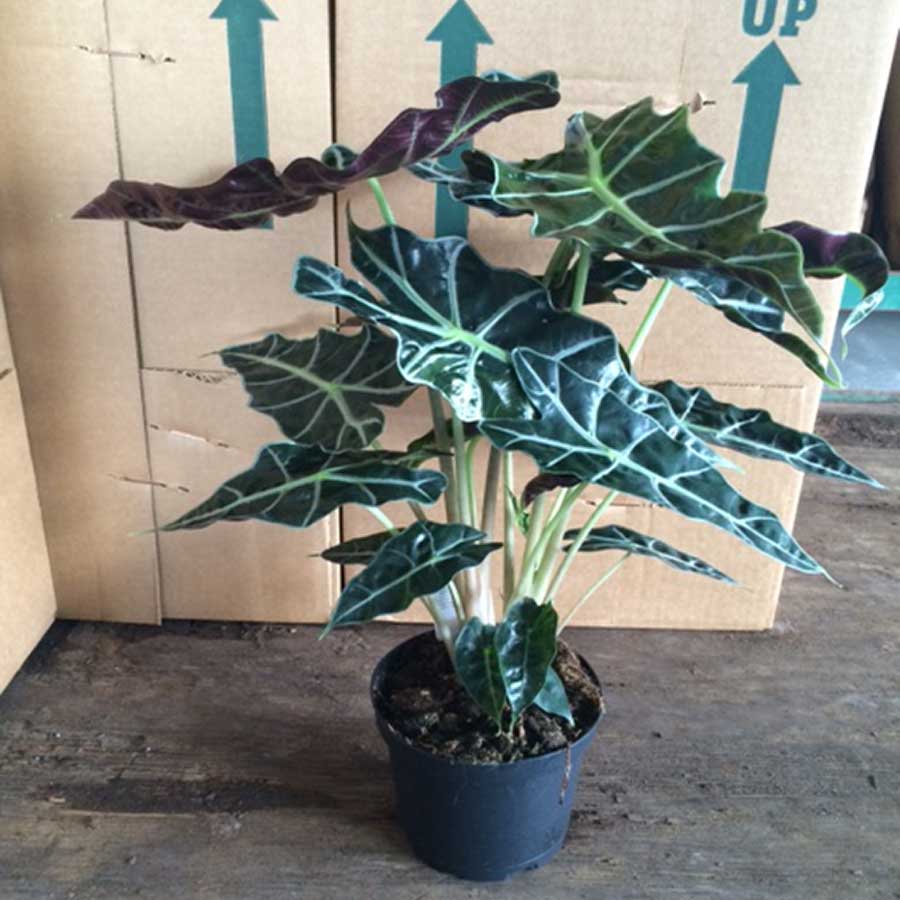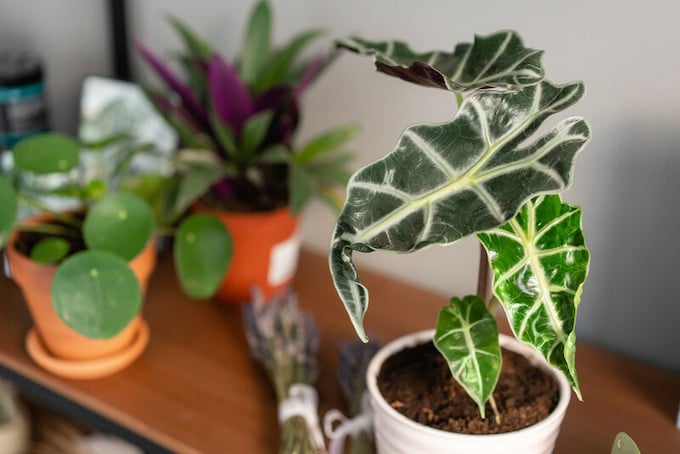An alocasia Polly is a unique member of the aroid family. The houseplant is a little bit temperamental and requires high maintenance level.
The stunning foliages mark with white veins makes a bold statement in any room. It is one of the reasons behind the popularity of this indoor plant.
A dying alocasia Polly could be due to improper care and maintenance. The issue is common among novice gardeners with less knowledge about alocasia Polly care.
You Might Also Enjoy: How to Care for Alocasia Amazonica Plant
So, why is my alocasia Polly dying? The possible causes are improper watering, nutrient deficiencies, temperature stress, low humidity, poor lighting condition, and more.
The rule of thumb is to identify the causes and adopt the best measure to resolve them. Otherwise, your alocasia Polly will die.
This article provides detailed insight on the causes and how to save a dying alocasia Polly. Take the time to read through it and learn how to revive your houseplant like a professional.
You Can Also Read: Why Is My Alocasia Polly Turning Yellow?

Reasons Why My Alocasia Polly Is Dying?
I have been obsessed with alocasias for a decade now. But I admit that these tropical plants need ultimate care and attention than other indoor plants.
Alocasia Polly stems bending and leaves turning brown should never be ignored. It is a sign of a significant problem that might cause its death.
Take the time to inspect your houseplant and identify the root cause of the issue. Remember to provide a proper growing condition during the inspection.
Below are some of the answers to your question and steps on how to save a dying Alocasia Polly:
Overwatering Problem
Most alocasia Polly dies due to overwatering issues. The problem occurs as a result of improper soil drainage. Thus, the houseplant ends up growing in a soggy and waterlogged environment.
The growing condition usually limits air circulation within the soil. The roots find it challenging to carrying their usual functions like water and mineral absorption.
When the roots are deprived of oxygen for a long period, your alocasia leaves will begin to die one by one. Once the alocasia lost all leaves, it will start to die slowly.
Besides that, waterlogged soil can result in root rot disease. The root fungal disease will cause ultimate wilting of this alocasia species if not fixed on time.
How to Fix It
- Investigate the plant more often to spot any signs of overwatering.
- Re-pot the plant to a container with drainage holes and aerated soil.
- Always check the soil moisture content before watering the houseplant.
Underwatering Issue
Alocasias thrive in a condition with moderate moisture content in the soil. Too much or little water content in the soil will cause its death.
Underwatering limits the houseplant from carrying out their physiological processes. Alocasia Polly wilting and drooping leaves are the initial signs of inadequate water.
If this condition persists for an extended period, the houseplant will eventually die. But the underwatering problem is easy to identify and fix.
Read Also: Why Is My Alocasia Zebrina Drooping?
How to Fix
- Insert your index figure into the soil
- Examine the soil moisture content level
- Water the plant if about 2-3 inches of the soil is dry
- Come up with a strict watering schedule depending on the season
Note: Water the houseplant twice or thrice a month in spring and summer. Alocasia Polly dormancy happens in winter and watering should happen once a month.
Nutritional Deficiency
Alocasia Polly is not a heavy feeder. But the houseplant needs some nutrients to maintain its large and stunning leaves.
Alocasia Polly dying due to lack of nutrients is a rare circumstance. But the issue happens if the owner is careless and fails to provide the required nutrition.
If you notice your alocasia Polly leaves turning red or yellow, it is due to insufficient nutrients in the soil. Besides that, you will notice alocasia leaves dying one by one.
How to Fix
- Buy a well-balanced liquid fertilizer
- Apply to the houseplant every two months
Note: Apply fertilizer to alocasia Polly in spring and summer. Alocasia Polly dormancy occurs in winter, and there is no need for fertilization.
Improper Lighting Condition
Alocasia plants grow under the canopy in their natural habitat. It implies that the plant can tolerate low-moderate lighting for survival.
But extremely low lighting conditions will inhibit photosynthesis from taking place. The large deep-green leaves will begin to fade and stop undertaking their physiological activities.
You will notice the houseplant growing leggy and stems bending. Sometimes, this houseplant will end up dying if the condition persists.
Placing alocasia Polly in direct sunlight will cause leaf sunburn. It will also cause alocasia Polly stems bending and death if the condition prolongs.
You May Also Like: Why Are My Alocasia Leaves Curling?
How to Fix
- Place the plant near the window to receives bright indirect sunlight
- Add a curtain to the window to prevent heat from scorching the leaves
Temperature Stress and Drafts
Alocasia Polly flourishes under a temperature range of 18-12oC (65-85oF). The indoor temperature dynamics make the plant susceptible to hot and cold drafts.
Low temperature causes stunted growth and chilling injuries. If the condition persists for an extended period, the houseplant will eventually die.
Hot drafts from heaters and radiators are also harmful to the plant. The heat causes alocasia Polly stems bending and leaves drooping. Saving a dying alocasia from a high temperature can be tricky.
How to Fix
- Keep your plant away from heaters and radiators
- Provide the optimum temperature requirement
Note: You can buy a digital garden thermometer to help detect temperature changes in the house throughout the growing season.
Low Humidity Level
The native habitat of alocasias has a high humidity level. It would be best to replicate the same condition at home to experience better growth and beautiful foliages.
Alocasia Polly cannot tolerate dry air condition at all. The houseplant will display displeasure through the leaves and stems.
Alocasia Polly stems bending and wilting are a sign of low humidity. Failure to fix the problem on time, the houseplant might die.
How to Fix
- Mist the plant more often
- Install an electric humidifier in the house
Note: You can also buy a 2 in 1 hygrometer thermometer. The device will help you monitor your indoor humidity level and temperature change.
You May Also Enjoy: Why Are My Alocasia Leaves Turning Brown?

You May Also Read: How to Care for Alocasia Black Velvet
Frequently Asked Questions
Why Are My Alocasia Leaves Turning Yellow?
Improper soil moisture, watering, and low lighting conditions are the leading cause of alocasia leaves turning yellow. Low humidity and underwatering also cause leaves drooping and wilting.
Do Alocasia Polly Go Dormant?
Alocasia Polly dormancy happens in winter. I recommend keeping your houseplant in a warm location and avoid watering more often.
How Often Should I Water Elephant Ear Plant?
Water the plant twice or thrice in summer and spring. Limit the watering routine in winter but do not leave the soil to dry completely. Elephant ear plants use less water in winter due to dormancy.
Can Alocasia Grow in Water?
All alocasia species cannot grow in water due to root rot. Damp soil inhibits root aeration and absorption of essential nutrients. Alocasia leaves turning yellow and drooping are signs of excess moisture in the soil.
Why Is My Alocasia Not Growing?
It is due to the provision of unsuitable indoor growing conditions. Alocasias thrive in an environment with high humidity, bright indirect sunlight, moderate soil moisture, and more.
You Might Also Like: 20 Beautiful Alocasia Varieties with Names and Pictures
In Conclusion
Many factors make alocasia Polly die. It would be best to provide the required growing condition for the houseplant to survive for an extended period.
Consider learning more about alocasia Polly care to experience better results in the long run. Remember to exercise patience and constantly observe the plant to notice any changes.
Alocasia Polly is not ideal for beginners. But through proper care and maintenance, a novice gardener can grow the alocasia species at home.
You Can Also Read: 15 Best Calathea Varieties with Pictures and Names
More Sources and References
- Editor. Alocasia Common Problems. North Carolina State University.
- Editor. Elepant Ear Plant Issues. University of Wisconsin.
